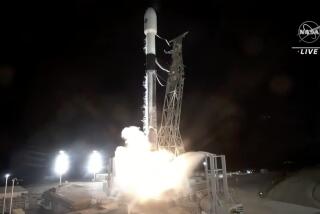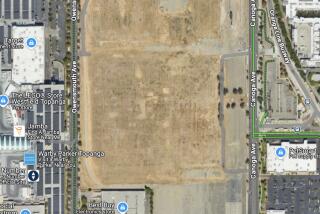Air Force Still Prefers Trucking of Rocket Fuel : Study: Officials say hauling the dangerous chemicals through Southern California is preferable to moving it by barge or rail.
- Share via
WASHINGTON — The Air Force has concluded that its current practice of trucking dangerous rocket fuel to Vandenberg Air Force Base through Southern California is preferable to shipping it by barge through the Panama Canal or transporting it by rail, Pentagon officials said Tuesday.
An 18-month Air Force study found that transporting the volatile chemicals--which are poisonous and explosive--by barge is infeasible, although moving them by rail through the San Fernando Valley and Ventura County merits further review. But the initial assessment determined that trucking them through the Mojave Desert north of Los Angeles to the base near Lompoc remains the best option, Capt. Sigmund Adams said.
The report cited Coast Guard regulations prohibiting bulk shipments of rocket fuels by barge and capital outlays needed to transport them by rail. In addition, it said that in an accident, either method could jeopardize more people than trucking because barges and rail cars would carry larger shipments than trucks.
The assessment was requested by Rep. Robert J. Lagomarsino (R-Ojai) in late 1987 in response to reports that components of the fuel used to launch military rockets were being shipped by truck on the Ventura Freeway through the densely populated San Fernando Valley and northward through Ventura County.
The chemicals include nitrogen tetroxide, which can be fatal if inhaled.
Protests by elected officials over trucking the fuel components through the San Gabriel Valley--across Pasadena, Glendale and Burbank--and then through the San Fernando Valley and into Ventura County prompted the Air Force to redirect the shipments.
A northern highway route through less-populated Barstow, Mojave, Gorman, Mariposa and Santa Maria was selected.
“These propellants have been shipped via tank trailer over the nation’s highways for more than 25 years without a single recordable accident or incident resulting in a spill or major loss of product while in transit,” said the San Antonio Air Logistics Center at Kelly Air Force Base in San Antonio in an executive summary of the study. The center conducted the study for the Air Force.
Lagomarsino has asked the House Merchant Marine Committee and Fisheries and Government Operations Committee to review the nearly 200-page study, which was completed in December and released to the lawmaker Tuesday.
In the meantime, Lagomarsino expressed disappointment that the Air Force did not fully assess the idea that shipping the rocket fuel by barge could enhance safety. He also dismissed consideration of the rail option.
“It would appear on the face of it the rail shipment would expose many more people to risk than the current truck routing” by taking larger shipments of the fuels through more heavily populated areas than the current highway route, said John Doherty, a senior aide to Lagomarsino.
Rail shipments would be carried on the Southern Pacific railroad coastal route, which parallels the Ventura Freeway through the San Fernando Valley, eastern Ventura County and Santa Barbara.
The Air Force study assessed the operational, regulatory, and risk and safety factors of five means of transportation: barge containers; rail cars or tractor-trailers carried by barges; rail tank cars; containers or tank trucks on flat-bed railroad cars and one-ton cylinders or drums on rail cars.
The Air Force said it did not assess whether shipping the fuel in barge containers would improve safety because it found that Coast Guard regulations prohibit the shipping of rocket fuels by barge. At the same time, it said transporting the fuel in rail cars or tank trucks on barges would place fewer people at risk because of the remoteness of the water route.
But, it added, “Handling risk associated with barge transport appears considerably higher than for the rail modes, and mitigated the risk benefits of remote water routes.”
Doherty, however, maintained that Congress could modify the Coast Guard regulations and that perhaps the potential benefits of shipment by sea would make the effort worthwhile.
“The safety aspect was the whole reason for the study,” Doherty said. “The risks may have been so much less compared to anything else that it would have justified the additional hassle.”
Air Force spokesman Adams said he was unable to respond immediately to Doherty’s assertion.
Nitrogen tetroxide is transported in 3,057-gallon trucks across seven states from Vicksburg, Miss., where it is manufactured, by a company under contract with the Air Force. As many as two rocket fuel shipments are made each month, depending on Vandenberg’s launch schedule, although there have been none in 1990, said Phoebe Brown, a San Antonio Air Logistics Center spokeswoman.
More to Read
Sign up for Essential California
The most important California stories and recommendations in your inbox every morning.
You may occasionally receive promotional content from the Los Angeles Times.










